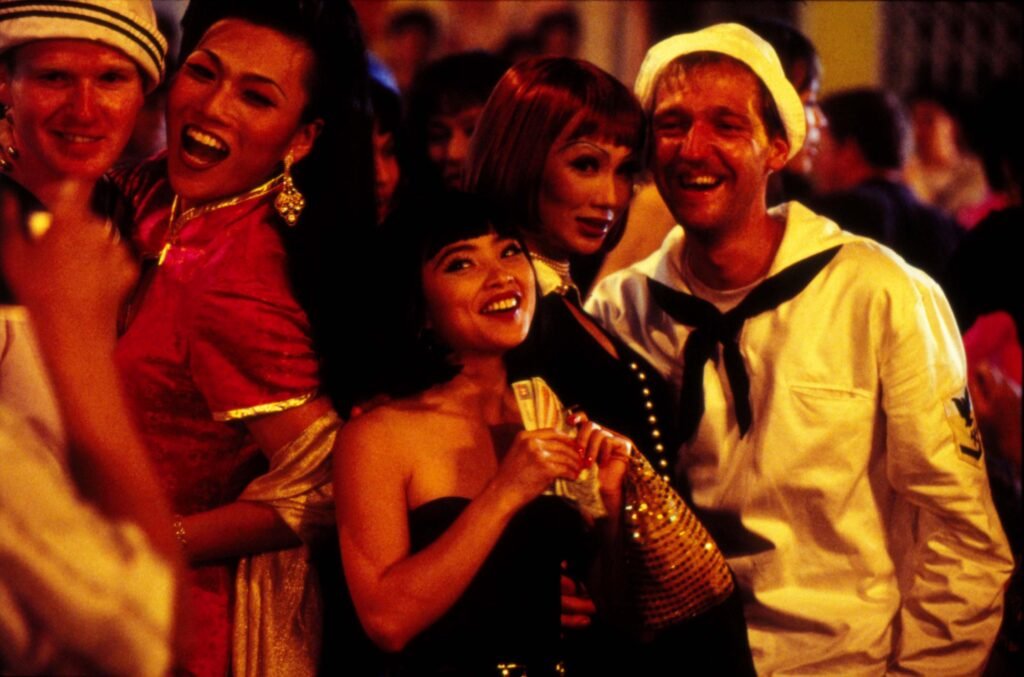
The movie starts with a POV shot of an ongoing party where a bisexual gets intimate with American soldiers. Not long into the movie, Lola, gets introduced while riding in the back of a Tri Shaw alongside her American companion on rout to Sin Sin hotel where she stays. The American Sailor seems to forget about the payment after a very loud and crazy night since he only realizes the transsexuals’ nature of Lola, however she reminds him the payment will be enforced once she threatens to call her triad gang.
The Second character, Lien, a 16 year old girl from Malaysia, on the other hand, embarks on a different journey. She traveled all the way from Malacca, where she worked as a maid at a luxury home to Singapore with a dream of getting hired as a receptionist in Sin Sin, while still being a stranger to the prostitution trade. But to her surprise when she entered the Trois she discovered that the women who often hung out there were mostly transsexual prostitutes, but over time she became a kind of mascot for all of them.
After Drago, as Lian puts it, a friendly face, who has been living all the while in Europe, walks into the hotel, she starts undergoing unusual Lian experiences throughout all the romances and adventures that all the girls get themselves involved in.
This Lian experience is actually one of the three major plots of the transsexual story, “Bugis Street”, the other two more or less setting the context, the time period and the lifestyles of the various transgender protagonists who appear in the tale. It is in this simple method that Yonfan blends all the fragments, seeing that all three components set other sections of the film and book resting in an equally important manner. That aspect is even more pronounced when we assert that the narrative written by Yonfan, Fruit Chan and Yuo Chan adopts an episodic structure such as the three elements already mentioned above.
Meng, a hyper textualistic figure who becomes the primary initiator of male frontal nudity in the book who later comes on to Lain, also becomes part of paso and YY romance. Their brawls are quite entertaining and sometimes even comical.
It is clear that Yonfan’s decision to restrict Lian from cherishing her attraction is worthwhile since such an event would tend to overshadow all the other elements, and is also a girl’s analysis which is among the best aspects of the entire movie. Rather, how she assists Lian in adjusting to her burgeoning sexuality and her relationship with her ill mother Drago explains part of the historical context of trans people in Singapore and more about the psychological complexity of Lian.
Kyra speaks of this as a very important point for the film because these women are in effect reduced to objects used for sex and for the relief of sexual tension, yet Yonfan is also careful to show that they are women who enjoy this form of existence, at least up to a certain point. It is fair to say that this portrayal leaves much to be desired since they certainly have been marginalized by society and the hotel acts as a ghetto and the expression of Lian when she first discovers that they are men illustrates the perception of them held by the key population.
What however makes the story even more interesting is the role played by Lian who has been portrayed in the film as a rather simple, naive girl who only learns through the hard, disheartening way how the reality works with the help of her deep friendship with Drago, the first pangs of love and the fantasies she tries to tell herself all performed well in the film.
In addition, the feeling of loss which accompanies her while observing the comings and goings in the hotel and the realizing of changes gives the movie a fascinating nostalgia, and this feeling is complemented by the wonderful sound track as well. The role of Vietnamese Hiep Thi Le is great, both in her general fire and gaiety, and in the sad or disappointing moments, doing a depth role in the film for the applicant.
In terms of the performance, it’s Ernest Seah as Lola and Greg-o as Drago that take the lead, presenting their completely opposite, but equally flamboyant, characters. Michael Lam as Meng on the other hand, seems to be playing the role of “The handsome” in the sense that he spends the majority of the time on display rather than talking, which can also be viewed as a form of satire for the way beautiful women were stereotyped in non-LGBT movies during that period.
Last but not least, the in-depth portrayal of the period and the life stories of the transgender are surely one of the merits of the film, and both are done by DP Hon-Pong Tang in a very imaginative and realistic way.
They ought to be commended for tact and sensitivity in all of their work and not just for their excellent Singaporean piece. As the tiny hotel is made into a world in particular, I now recall the sex and the bodies of the main characters portraying a novel out of the imagination which is interesting to watch. Also, the low-angle shots are quite thought-provoking, as they sometimes turn the story to be a bit like a mockumentary. Ma Kam’s editing does provide a sense of haste which goes along well with the title’s episodic fighting style.
I found “Bugis Street” to be a fantastic movie that manages to be both entertaining and true to life. As it showcases Singaporean society beautifully, I think it’s worth seeing.
For more movies like Bugis Street (1995) visit solarmovie







